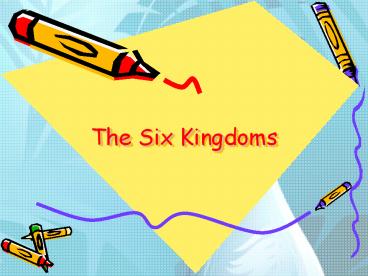The Six Kingdoms PowerPoint PPT Presentation
1 / 26
Title: The Six Kingdoms
1
The Six Kingdoms
2
- Scientist place all living things into
- one of the three domains Eukarya, Bacteria, and
Archaea. - They are there based on the following
characteristics of the organism - Cell type
- Ability to make food
- The number of cells in their bodies
3
- The Kingdoms are Archaebacteria, Eubacteria,
Protista, Plantae, Fungi, and Animalia - Each organism in a KINGDOM is then placed in
subgroups within the KINGDOM based on
characteristics. The subgroups are phylum,
class, order, family, genus, species
4
- The smaller the subgroup, the more
characteristics the organisms have in common in
that group - The bigger the subgroup, the fewer
characteristics the organisms have in common. - Phylum is the largest subgroup
- Species is the smallest subgroup
5
- Members of subgroups may have different physical
characteristics and still be in the same subgroup - Example Bulldogs and poodles look very
different but they are still the same species. - Wolves look like some dogs but they are NOT the
same species however, they are the same genus.
6
Basis for Modern Taxonomy
- Homologous structures (same structure, different
function) - Similar embryo development
- Similarity in DNA, RNA, or amino acid sequence of
Proteins
7
Homologous Structures show Similarities in
mammals.
8
KINGDOM
PHYLUM What is in kingdom that is not in phylum?
CLASS What is in Phylum that is not in class?
Bird It does not nurse its young.
ORDER What was eliminated at this level?
Human and whale, neither have meat tearing teeth.
FAMILY Which organism is not in family but was
in order?
Bear, it cant roar
GENUS What animal has been eliminated at this
level?
Lion, it doesnt purr.
SPECIES The lynx has different physical
characteristics and is not domesticated so that
leaves the cat.
9
The Kingdoms Archaebacteria Eubacteria
Salt, heat, acid lovers Methane producers
Largest of the bacteria kingdoms Contains
Producer consumer bacteria
Three Shapes Rod, Spheres, or Spiral
10
Protista Plant
11
Fungi Animals
12
Since neither plant nor animal fits this
organism, scientists added another kingdom for
classifying organisms Protista!
- Euglena are a species if single-celled organisms
that live in pond water - Euglena are green and like most plants, can make
their own food through photosynthesis. - What do you think this is?
- Euglena can move about from place to place by
whipping their tails called flagella. - Sometimes Euglena use food obtained from other
organisms.
It is not a plant
Plants dont move and usually do not eat other
organisms. Does this mean Euglena are animals?
13
- Scientists use tools to help identify organisms
- Field Guides-books with pictures and
descriptions. - Dichotomous Keys-a detailed list of identifying
characteristics that includes scientific names. - Dichotomous Keys are arranged in steps with two
descriptive statements at each step.
14
- Dichotomous keys have two steps at each
characteristic. - Example Hair color 1a Blond hair
- 1b Not blond
hair - YOU ALWAYS HAVE ONE LESS STEP THAN THE AMOUNT OF
ITEMS THAT YOU WILL WRITE CHARACTERISTICS ON!!!!! - EXAMPLE IF YOU HAVE 10 ITEMS TO BE IDENTIFIED,
YOU WILL HAVE ONLY 9 STEPS, A AND B.
15
Dichotomous Keys
- Used to identify organisms
- Characteristics given in pairs
- Read both characteristics and either go to
another set of characteristics OR identify the
organism
16
Purpose
- A dichotomous key is a tool that allows the user
to determine the identity of items in the natural
world, such as trees, wildflowers, mammals,
reptiles, rocks, and fish. - Keys consist of a series of choices that lead
the user to the correct name of a given item. - "Dichotomous" means "divided into two parts".
Therefore, dichotomous keys always give two
choices in each step.
17
Example of Dichotomous Key
- 1a Tentacles present Go to 2
- 1b Tentacles absent Go to 3
- 2a Eight Tentacles Octopus
- 2b More than 8 tentacles 3
- 3a Tentacles hang down go to 4
- 3b Tentacles uprightSea Anemone
- 4a Balloon-shaped bodyJellyfish
- 4b Body NOT balloon-shaped - 5
18
In constructing keys, keep the following in mind
- Use measurements rather than terms like "large"
and "small". - Use characteristics that are generally available
to the user of the key rather than seasonal
characteristics or those seen only in the field. - Do not use opinions (ugly, fat, short)
19
Lets practice
- List 6 types of candy
- Come up with a way to divide the 6 candies into 2
distinct groups.
20
- Create a dichotomous key using the following
organisms.
21
(No Transcript)
22
Haliaetus leucocephalus (Bald Eagle
23
Pandion haliaetus (Osprey
24
Buteo jamaicensis (Red-tailed hawk)
25
Falco sparverius (Sparrow Hawk)
26
Cathartes aura (Vulture)

